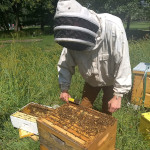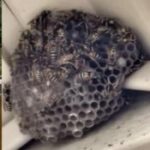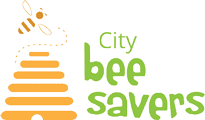EMPLOYMENT OPPORTUNITIES
Interested? Please reach out to us at 630-660-9846 or citybeesavers@gmail.com

Beekeeper Opportunities
We have beekeeper positions available throughout the spring, summer, and fall seasons.

Wasp & Hornet Removal Positions
There are several positions available for steady wasp removal work from mid-summer to late fall each year.
BEEKEEPING
There are two primary beekeeping positions available: hive management and honey bee removal.
BEEKEEPING
City Bee Savers manages between 150 - 200 colonies during the summer. The majority of those colonies are part of our Bee Buddy Program. The remaining hives are maintained for clients. This is a rare opportunity to learn professional beekeeping skills from Bill, while observing most honey bee characteristics throughout the spring, summer, and fall seasons.
SKILL REQUIREMENTS:
- Beekeeping experience is helpful, but not required
- Ability to lift between 50 lbs and 75 lbs
- Have transportation
- Some carpentry skills
- Works quickly
- Can record notes about each colony
JOB DESCRIPTION:
- Help maintain beehives in the Western Suburbs and on top of buildings in Chicago's Loop (inspections every 9 days)
- Assist with queen rearing in West Chicago and Wheaton
- Start new hives (NUCs) throughout the summer
- Check and treat for mites
- Feed in the spring and fall when needed
- Assemble hive boxes
- Help correct colony problems when they arise
- Help extract and bottle honey
- Write hive status reports
HONEY BEE REMOVAL
City Bee Savers is a fully licensed and Insured Structural Pest Control company. We perform over 60 honey bee removals per summer throughout the Chicagoland area. This is an opportunity to see honey bee colonies in their natural environment while earning in the process.
SKILL REQUIREMENTS:
- Must have basic carpentry skills
- Must be able to work on a 15' ladder
- Must be able to carry heavy ladders, pails of honey, and equipment up and down ladders
- This job often demands detective skills for finding and retrieving the colony
- Applicant must be somewhat inventive - bees can be located in some pretty out-of-the-way locations
- Must be comfortable working with honey bees
- Have transportation
JOB DESCRIPTION:
There are many different situations where a honey bee colony will locate in a home. On the outside of the home, they are typically nesting in a soffit. On the inside of the home, they typically will locate in a ceiling between a first and second floor.
OUTSIDE
-
- First identify the colony location. Locating them does take skill and observation. Knowing how the home is constructed is most helpful. Once we have a general idea of their location, we can usually find the colony with our thermal camera. Occasionally, to check how extensive a colony is, we will use our endoscope camera.
- A ladder jack assembly is erected to have a platform to work from when removing the bees.
- The soffit boards are removed. There is usually an order to this process and will take some learning.
- A bee vacuum is used to remove the bees.
- All the comb is removed, the hive cavity is fully cleaned, and the cavity is spray painted and filled with insulation.
- All soffit boards are re-attached.
- The truck is packed. Bees are kept cool throughout the day with fans and loaded in the truck so they have ventilation and won't overheat.
- The bees are installed into a hive at one of our bee yards. They may need to be fed at this time.
- Return to the hive in a couple days to check on their progress.
INSIDE
-
- Identify the colony location. Locating them does take skill and observation. Knowing how the home is constructed is most helpful. Once we have a general idea of their location we can usually find the colony with our thermal camera. Occasionally, to check how extensive a colony is we will use our endoscope camera.
- The room inside the home will need to be closed off from the rest of the house so bees do not move past the work site. It is best to have at least 10' x 10' clear for working space. If the room cannot be closed off it may be necessary to construct a plastic enclosed in the work area.
- Typically the bees are located in a ceiling. Drywall will need to be removed. This takes some skill to perform so the drywall can be easily re-attached.
- A bee vacuum is used to remove the bees.
- All the comb is removed, the hive cavity is fully cleaned, and the cavity is spray painted and filled with insulation.
- All drywall is re-attached and taped/mud applied.
- The truck is packed. Bees are kept cool throughout the day with fans and loaded in the truck so they have ventilation and won't overheat.
- The bees are installed into a hive at one of our bee yards. They may need to be fed at this time.
- Return to the hive in a couple days to check on their progress.
WASP REMOVAL
We will train you on all types of removals and supply you with a kit with required tools and equipment.
SKILL REQUIREMENTS:
- Willing to climb ladders (15')
- Can carry large ladders
- Must have some carpentry skills or have the ability to learn
- Good at evaluating situations
- Must have a vehicle to travel to job sites around Chicagoland area
- Must have phone and ability to text pictures
- Works safely and efficiently
JOB DESCRIPTION:
- Coordinate job address, dates, and specifics with our communications director
- Maintain phone contact with our certified tech
- Assess the type of removal, i.e. in ground, tree, soffit, wall, attic, etc...
- Identify the species and find the exact nest location
- If nest is in a home, assess how you'll access the nest. This may require removing soffit covering, etc.
- Remove nest (spray during process), bag the nest and all refuse, clean and remove any mess
- If it isn't possible to remove nest, understand how to treat nest foragers effectively
